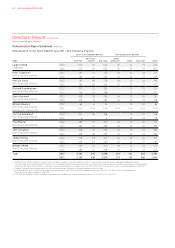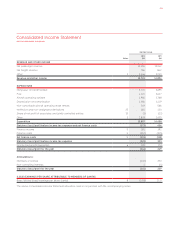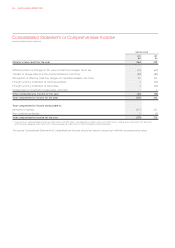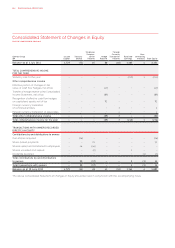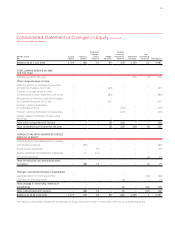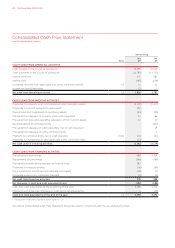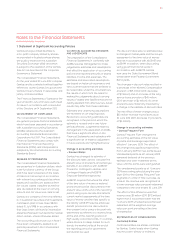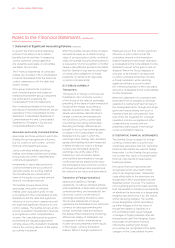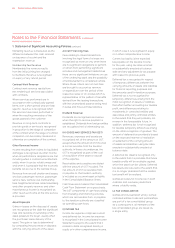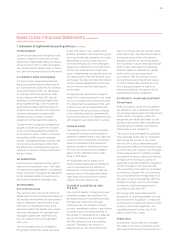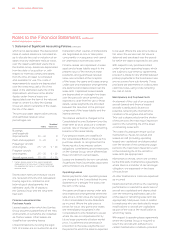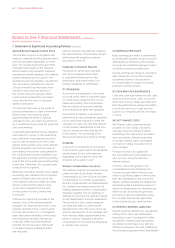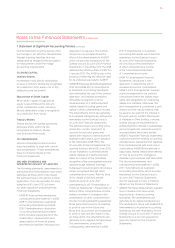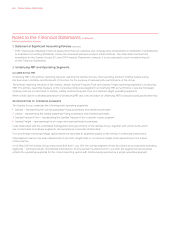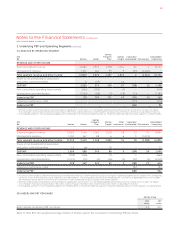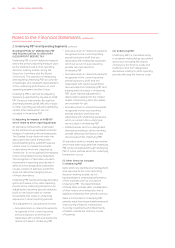Qantas 2012 Annual Report Download - page 74
Download and view the complete annual report
Please find page 74 of the 2012 Qantas annual report below. You can navigate through the pages in the report by either clicking on the pages listed below, or by using the keyword search tool below to find specific information within the annual report.
FOR THE YEAR ENDED 30 JUNE 2012
Notes to the Financial Statements continued
to govern the financial and operating
policies of an entity so as to obtain
benefits from its activities. In assessing
control, potential voting rights that
are presently exercisable or convertible
are taken into account.
The Financial Statements of controlled
entities are included in the Consolidated
Financial Statements from the date that
control commences until the date that
control ceases.
Intra-group transactions, balances
and unrealised gains and losses on
transactions between group companies
are eliminated in preparing the
Consolidated Financial Statements.
Non-controlling interests in the results
and equity of controlled entities are shown
separately in the Consolidated Income
Statement, Consolidated Statement of
Comprehensive Income, Consolidated
Statement of Changes in Equity and
Consolidated Balance Sheet.
Associates and Jointly Controlled Entities
Associates are those entities in which the
Qantas Group has significant influence,
but not control or joint control, over the
financial and operating policies.
Jointly controlled entities are those
entities over whose activities the Qantas
Group has joint control, established by
contractual agreement.
Investments in associates and jointly
controlled entities are accounted for
using the equity accounting method.
The investments are carried at the
lower of the equity accounted amount
and the recoverable amount.
The Qantas Group’s share of the
associates’ and jointly controlled
entities’ post-acquisition profit or loss
is recognised in the Consolidated Income
Statement from the date that significant
influence or joint control commences until
the date that significant influence or joint
control ceases. The Qantas Group’s share
of post-acquisition movements in reserves
is recognised in other comprehensive
income. The cumulative post-acquisition
movements are adjusted against the
carrying value of the investment. Dividends
reduce the carrying amount of the equity
accounted investment.
When the Qantas Group’s share of losses
exceeds its equity accounted carrying
value of an associate or jointly controlled
entity, the Qantas Group’s carrying amount
is reduced to nil and recognition of further
losses is discontinued, except to the extent
that the Qantas Group has incurred legal
or constructive obligations or made
payments on behalf of an associate
or jointly controlled entity.
E FOREIGN CURRENCY
Transactions
Transactions in foreign currencies are
translated to the functional currency
of the Group at the rates of exchange
prevailing at the date of each transaction
except where hedge accounting is
applied. At balance date, monetary
assets and liabilities denominated in
foreign currencies are translated to
the functional currency at the rates
of exchange prevailing at that date.
Resulting exchange differences are
brought to account as exchange gains
or losses in the Consolidated Income
Statement in the year in which the
exchange rates change. Non-monetary
assets and liabilities that are measured
in terms of historical cost in a foreign
currency are translated using the
exchange rate at the date of the
transaction. Non-monetary assets
and liabilities denominated in foreign
currencies that are stated at fair value
are translated to the functional currency
at foreign exchange rates prevailing at
the dates the fair value was determined.
Translation of Foreign Operations
Assets and liabilities of foreign
operations, including controlled entities
and investments in associates and jointly
controlled entities, are translated to the
functional currency at the rates of
exchange prevailing at balance date.
The income statements of foreign
operations are translated to the functional
currency at rates approximating the
foreign exchange rates prevailing at
the dates of the transactions. Exchange
differences arising on translation are
recognised in other comprehensive
income and are presented within equity
in the foreign currency translation
reserve. When a foreign operation is
disposed of such that control, significant
influence or joint control is lost, the
cumulative amount in the translation
reserve related to that foreign operation
is reclassified to the Consolidated Income
Statement as part of the gain or loss on
disposal. When the Group disposes of
only part of its interest in an associate
or jointly controlled entity that includes
a foreign operation, while retaining
significant influence or joint control,
the relevant proportion of the cumulative
amount is reclassified to the Consolidated
Income Statement.
When the settlement of a monetary item
receivable from or payable to a foreign
operation is neither planned nor likely in
the foreseeable future, foreign exchange
gains and losses arising from such a
monetary item are considered to form
part of the net investment in a foreign
operation and are recognised in other
comprehensive income and are
presented within equity in the foreign
currency translation reserve.
F DERIVATIVE FINANCIAL INSTRUMENTS
The Qantas Group is subject to foreign
currency, interest rate, fuel price and
credit risks. Derivative and non-derivative
financial instruments are used to hedge
these risks. It is the Qantas Group’s policy
not to enter into, issue or hold derivative
financial instruments for speculative
trading purposes.
Derivative financial instruments are
recognised at fair value both initially
and on an ongoing basis. Transaction
costs attributable to the derivative are
recognised in the Consolidated Income
Statement when incurred. The method
of recognising gains and losses resulting
from movements in market prices depends
on whether the derivative is a designated
hedging instrument and, if so, the nature
of the risk being hedged. The Qantas
Group designates certain derivatives
as either hedges of the fair value of
recognised assets or liabilities or a
firm commitment (fair value hedges),
or hedges of highly probable forecast
transactions (cash flow hedges). Gains
and losses on derivative financial
instruments qualifying for hedge
accounting are recognised in the same
category in the Consolidated Income
1. Statement of Significant Accounting Policies continued
QANTAS ANNUAL REPORT 2012072


